Table of Contents
The Internet of Things (IoT) has revolutionized the use of technology since it allows efficient interaction among enormous amounts of devices and our lives. Malware has become more inclined towards IoT devices as the latter mostly suffer from poor security measures. These are items that are connected to IoT devices; the internet and other gadgets.
Malware can exploit this as the point of entry to your devices or maybe spread to other devices connected to the network. I have written up all about IoT malware and how you can protect your IoT devices from such malware in the article.
Which Possible Threats to IoT Security Exist?
Every customer should be concerned about Internet of Things security. Since the majority of us own at least one IoT device, we are vulnerable to internet dangers such as:
- Network Penetration and Hacking
- Cryptovirus
- Malicious Software
- Malware
- Device Piracy
- Unauthorized Access to IoT Devices
The bigger problem is that a large number of IoT devices are linked to a wider network, which might be impacted if one of those devices is compromised.
Ways to Secure Your IoT Devices:
In the under section, we have mentioned the ways to secure your IoT devices from malware:
Change Default Credentials and Turn on MFA
The default identities and passwords that many Internet of Things devices have are well-known to hackers. The first step in protecting your devices is to change these login credentials. Set unique, strong passwords for each device. To prevent malicious actors from accessing your devices without your permission, MFA adds an extra layer of security.
Keep Firmware and Software Updated
Regularly updating the firmware and software on your IoT devices is crucial. Manufacturers frequently provide updates to fix security flaws and enhance device functionality. When it’s feasible, turn on automatic updates, and check the websites and applications of your devices frequently for updates.
Segment Your Network
To prevent malware from spreading across your entire network if one device is compromised, segment your network. Make an IoT device network on a different subnetwork. The settings on your router can be used to accomplish this. In this manner, the malware’s reach is restricted even if just one device is compromised.
Disable Unnecessary Features
Many IoT devices provide extra capabilities and services that you might not require. You may choose to disable any feature or service that isn’t necessary for the operation of your device. This can reduce the potential attack surface and enhance security.
Use a Firewall
You can use a firewall to create a barrier between the internet and your IoT devices. It can filter both incoming and outgoing data, obstructing connections that can be harmful. You can customize the firewalls that are incorporated into a lot of routers.
Employ Network Monitoring
It is also possible to conduct surveillance of the traffic that passes between your IoT devices and the Internet depending on the available network monitoring tools. An infection by malware is characterized by things that are different from the norm or are not quite right. Other monitoring tools can also be used in detecting devices that use most of the bandwidth, which could be as a result of a compromised device.
Encrypt Your Data
Data encryption is essential for securing your IoT communications. Ensure that your devices and the services they communicate with use encryption protocols like HTTPS. This prevents eavesdropping and data interception by cyber criminals.

Regularly Audit Connected Devices
Periodically audit your IoT devices. If you no longer use a device or consider it redundant, disconnect it from your network. Reducing the number of connected devices can simplify network management and lower the risk of malware.
Cautious About Third-Party Apps
If your IoT device allows you to install third-party applications, exercise caution. Download apps only from trusted sources, and be mindful of the permissions these apps request. Malicious apps can pose a significant threat to your IoT device’s security.
Secure Your Router
An essential part of the security of your network is the router. Modify the default password on your router, ensure that its firmware is up to current, and turn off remote management if it’s not required. Additionally, consider using a strong, unique network name (SSID) to make it harder for attackers to identify your network.

Invest in IoT Security Solutions
Several companies offer dedicated IoT security solutions. These solutions can provide an extra layer of protection for your devices, monitoring and mitigating potential threats in real-time. Research and invest in a solution that aligns with your needs and budget.
Educate Yourself and Your Family
Make sure everyone in your household is informed about the dangers of IoT devices and the value of sound security procedures. Inform them of phishing efforts and teach them to spot shady online activity.
Finally,
Securing your IoT devices against malware is a process that never ends, this requires constant attention and effort. These risks are dynamic and constant with the evolution of the IoT environment in the world. The instructions spread in this article along with the most recent security updates can significantly decrease the probability of malware penetrating your IoT devices. However, it is important to remember that protecting IoT devices prolongs the safety of the digital environment for all by protecting not only your data.

